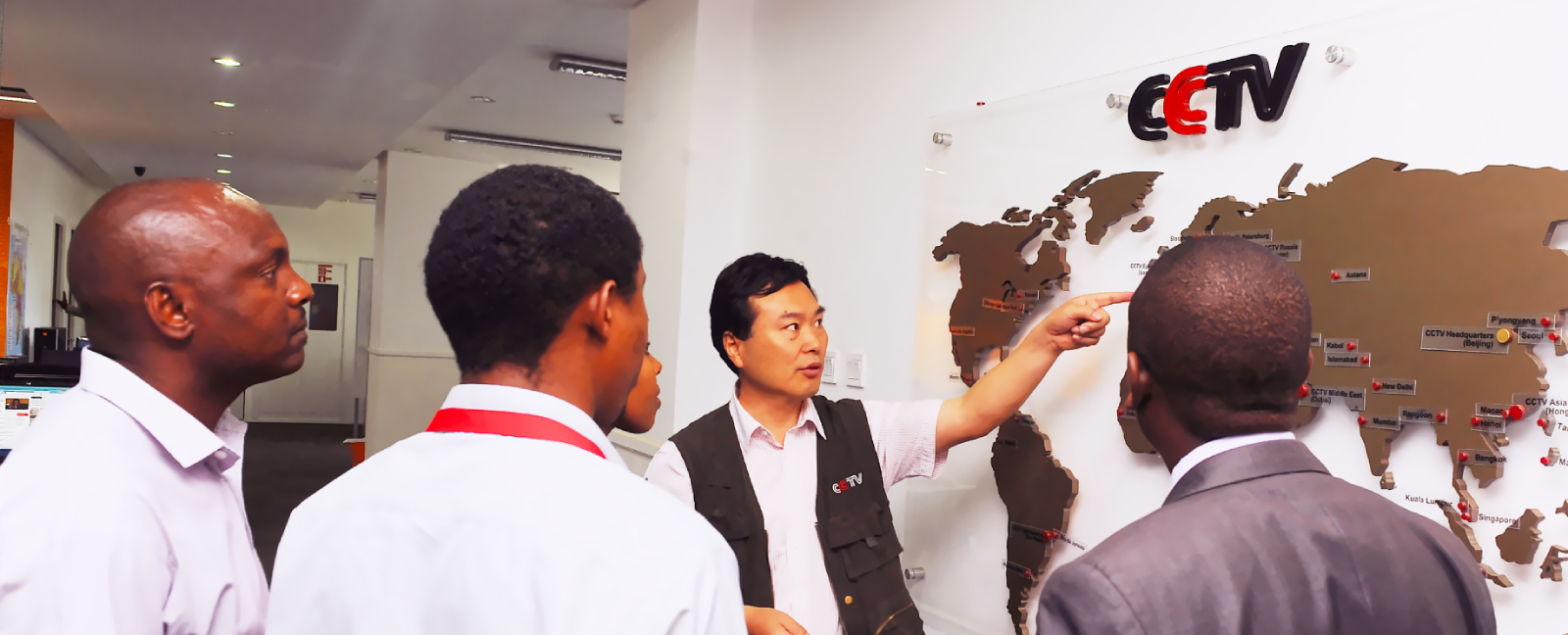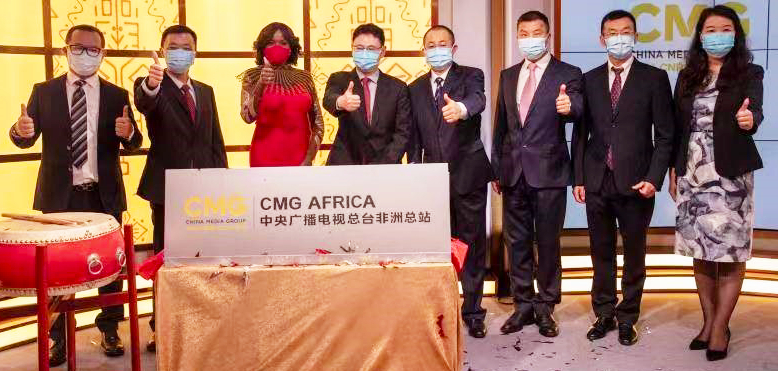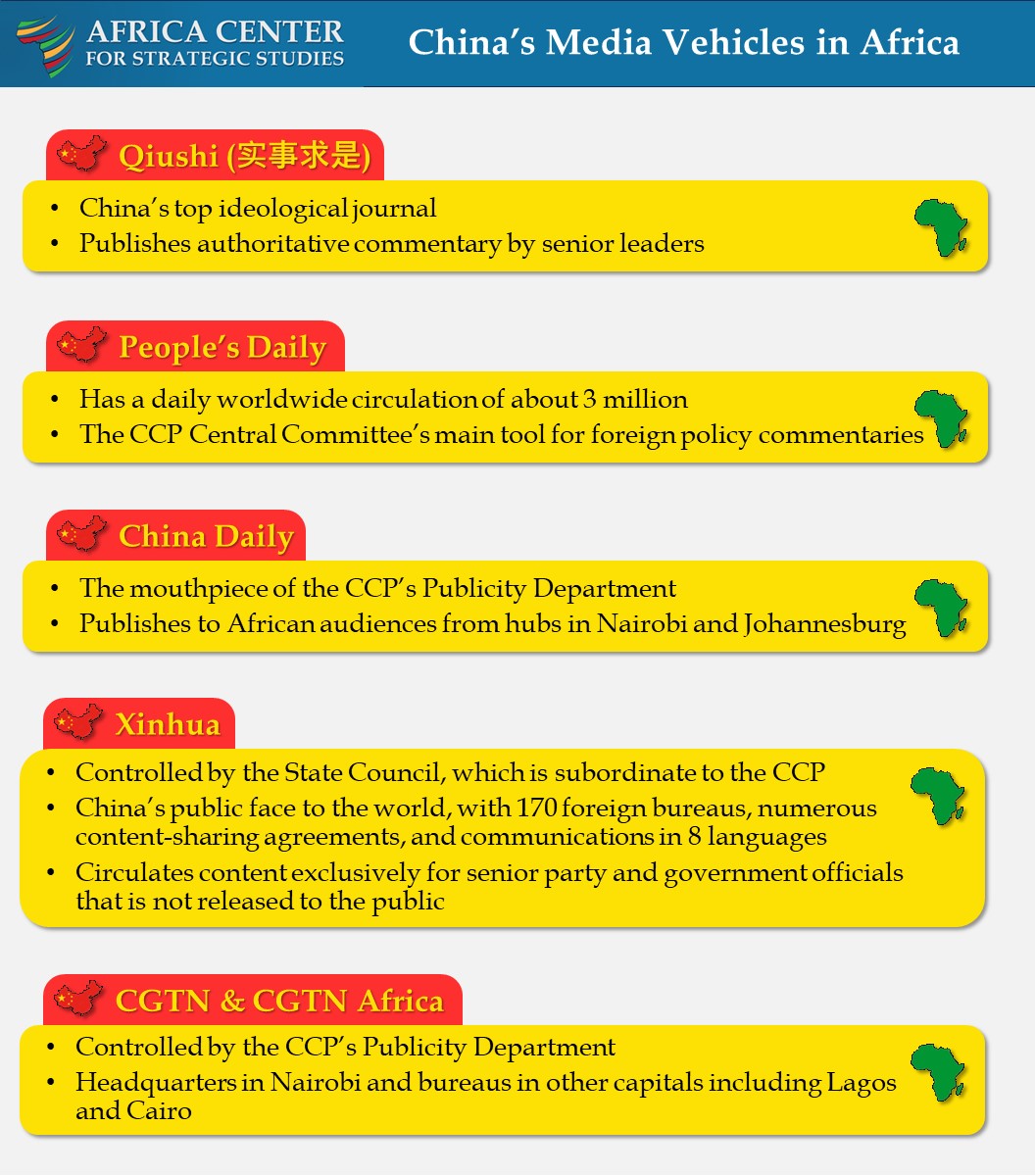
The managing editor of China Central Television (CCTV) talking to Kenyan journalists in Nairobi as he shows them how CCTV has expanded to different parts of Africa. (Photo: AFP)
China’s biggest media conglomerate, Xinhua, has 37 bureaus in Africa. This dwarves any other news agency—African or non-African—and is a dramatic increase from just a handful two decades ago. Another Chinese media giant, StarTimes, is China’s biggest player in African digital TV and the second largest in Africa after South Africa’s DSTV. StarTimes is installing satellite dishes in 10,000 rural homes across 20 African countries, linking them to Chinese digital TV, further embedding itself on the continent.
Many of Africa’s young journalists are trained in China and paid by Chinese media entities. In Kenya alone, 500 journalists and local staff are employed by Chinese media agencies, dispatching 1,800 news items monthly. Veteran China-trained Kenyan journalist Joseph Odindo, the former editorial director of Nation Media Group (East and Central Africa’s largest media conglomerate), notes that he had to keep close watch on his workforce while at the Standard Group. “[W]e had to draw up a chart which would enable us to see who was out on a Chinese training at any given time, who was due to come back, and who was next—otherwise you could find half of your newsroom is in Beijing undergoing training.”
The surge in Chinese investments in the African media space is part of a global strategy by the Chinese Communist Party (CCP) to gain influence in the developing countries by shaping their information environments.
The CCP views the media as a battleground for “telling China’s story well,” a phrase coined by CCP General Secretary Xi Jinping in 2013 at the party’s National Propaganda and Ideology Work Conference. China’s ruling party, according to its own policies, regards the media as an arena of combat to advance its narratives and policies and to discredit those of its adversaries without using military force. This invokes the Sun Tzu concept of “winning battles without fighting,” a concept CCP propagandists frequently use to describe their media offensives.
The embedding of CCP media in African media ecosystems risks distorting Africa’s information spaces.
The embedding of CCP media in African media ecosystems risks distorting Africa’s information spaces—and therefore access to independent information shaping citizen debates on a host of issues ranging from governance, society, and the economy. Chinese-supported media entities are expected to report favorably on the local regime and amplify their political projects and narratives. They do the same for Chinese investments regardless of local misgivings that frequently arise.
A case in point was the trouble encountered by the Standard Group when it published an investigative report on corruption in the Chinese-built Standard Gauge Railway, Kenya’s most expensive infrastructural project ever. According to Odindo, then the Standard Group’s editor, “the Chinese embassy and their communications manager canceled all their advertisements with [us]. … They demanded that we had to stop negative coverage.” That promptly ended the biweekly supplement the Chinese embassy funded that helped keep the paper afloat.
The practice of compliant and uncritical reporting undermines traditions of independent investigative journalism that have emerged across Africa since the 1960s. There are also concerns about the effect that China’s heavy media penetration are having on shaping public perceptions in ways that promote Chinese interests even when they undermine African citizen interests, as the Standard Gauge Railway case demonstrates.
The opportunity for expanding Chinese influence of Africa’s media space is facilitated by funding constraints that have limited the number of financially secure, independent Africa media outlets. Even fewer African media outlets cover news on the continent outside of their home countries and none can operate in China in the same way that Chinese entities do on their continent.
Only half of the 30 countries surveyed globally by Freedom House—including many in Africa—had media spaces that are resilient to such forms of CCP penetration. The remaining half are vulnerable, stemming from problems like lack of financial independence to persistent attacks by governments on their independence. This weakens a free press’s role as the people’s voice.
The “African Face” of China’s Media Narratives
African reporters are the face of CCP narratives and messages. This is a shift from the 1990s when Chinese journalists were more dominant. These African journalists are often recruited from other media houses with offers of better pay. Thousands of African journalists participate in media exchanges in China annually. The China-Africa Media Cooperation Forum regularly convenes African and Chinese writers to forge common perspectives on global issues.
China uses an array of tools to further integrate itself into African media systems. The China Africa Press Center places African journalists in Chinese media outlets on 10-month assignments where they work in Chinese news rooms and report on high-level CCP activities. The Belt and Road Journalists Network connects African journalists to their counterparts in other developing countries. Journalists are also part of the estimated 2,000 additional African professionals that benefit from the training slots provided triennially by the Forum on China-Africa Cooperation (FOCAC) in other fields besides journalism. The All-China Journalists Association, which works closely with the CCP’s United Front Work Department, manages China’s outreach to the Federation of African Journalists, which has a membership of over 150,000 members. The United Front Work Department coordinates China’s foreign influence operations.
The CCP’s Propaganda Department oversees China’s communications through the $6-billion “Voice of China” enterprise that consolidates news outlets into a single vehicle tasked with what China terms “seizing discourse power” (huayuquan; 话语权) , meaning “the right to speak and be listened to.” Money is key to all this. Chinese media entities support many African media houses struggling with poor equipment, low salaries, and tight budgets—but they expect favorable reporting in return.

Launch of the Africa headquarters of China Media Group, also known as the “Voice of China”. (Photo: 吴鹏)
To consolidate China’s voice, the CCP Propaganda Department provides free content, negotiates content sharing agreements with government and private broadcasters, pays handsomely for supplements, offers state-of-the-art equipment, buys stakes in leading media companies, and offers what top Chinese-trained Kenyan journalist Bob Wekesa calls “free junkets.” These entail a seemingly endless conveyor belt of African journalists going to China on fully paid trips where they receive first-class treatment and guided tours to instill positive images and experiences. According to Wekesa, “They [Chinese instructors] don’t tell you directly to be pro-China but, if you are discerning enough, you’ll understand that there are unspoken things expected from you in return.”
Xinhua’s content-sharing agreement with Kenya’s Nation Media Group gives Xinhua access to 8 radio and television stations in 4 East and Central African countries, 28 million social media followers, 11.3 million monthly viewers, and 90,000 daily newspaper circulations. Most of the content produced under these agreements come from African journalists, making their pro-China messaging less obvious. Many programs on Chinese media platforms also have an African feel. For example, China Global Television Network (CGTN) offers Africa Live, Talk Africa, and Faces of Africa, which showcase the achievements of highly successful African personalities and have proven to be popular with African audiences.
Africans do not buy the CCP model of absolute party control of the state, government, military, and society. Instead, 71 percent of Africans prefer democracy.
The jury is still out on the effectiveness of Chinese media though. The Nation Media Group’s Boniface Otieno questioned China’s self-censorship practices during his 10-month China Africa Press Center fellowship. “If the Chinese brought me to Beijing to influence my journalism, they failed.” For Alpha Daffae Senkpeni, the then-editor of Liberia’s daily newspaper FrontPage Africa, “The trip was designed to sell China’s image, yes, but I am not going to trade my principles. … If China wants to strike a good deal with Liberia I will support it, but if it is not in our interest I won’t.”
Others are more sanguine. Beatrice Marshall, a veteran Kenyan news anchor widely seen as CGTN’s “African voice,” says that Chinese outlets enable Africans to tell their stories “from our perspective.” She contrasts what she calls China’s “solution-oriented” approach with the “combative” Western journalistic style.
Chinese media have arguably been less successful in popularizing the Chinese governance model. Afrobarometer polls show that Africans do not buy the CCP model of absolute party control of the state, government, military, and society. Instead, 71 percent of Africans prefer democracy as the best form of government. Similarly, 81 percent reject one-party rule, 80 percent reject authoritarian rule, and 82 percent reject military rule. This, despite the fact that Chinese influence remains popular in Africa at 63 percent. Since 1999, Afrobarometer has found that China’s popularity in Africa does not in any way weaken the strong demand for democracy and accountability.
The CCP’s Media Policy Framework
The CCP’s policy architecture for media development, media offensives, and narrative management is multifaceted. The People’s Liberation Army (PLA) puts cognitive warfare on par with other domains of warfare like land, air, and sea. Duan Wenling and Liu Jiali, senior educators at the Military Propaganda Teaching and Research Department of the School of Political Science at China’s National Defense University, state that China’s approach to media warfare is to “shape the target audience’s macro framework for recognizing, defining, and understanding events.” According to Xi, “wherever the readers are, wherever the viewers are, that is where propaganda reports must extend their tentacles.”
Held every 5 years, the CCP National Congress regularly passes resolutions to strengthen China’s international communications, increase the “global appeal of Chinese culture,” and “build a system of discourse for the outside world.” These are translated into policy by the Central Leading Group on Propaganda, Ideological, and Cultural Work (CLG) (Zhongyang Xuanchuan Sixiang Lingdao Xiaozu, 中央宣传思想领导小组). The CLG are small teams of senior policymakers who coordinate policy implementation across the government and party.
The PLA puts cognitive warfare on par with other domains of warfare like land, air, and sea.
This CLG controls all propaganda, publicity, and information of the CCP and Chinese government. It is led by Cai Qi, the fifth ranking member of the seven-man Politburo Standing Committee—China’s highest leadership organ. He is also the director of the CCP General Office and the General Secretary’s (Xi Jinping’s) Office. Cai is deputized by Li Shulei, the head of the CCP’s Publicity Department, which in Chinese is called the Central Propaganda Department (Zhongxuanbu; 中宣部).
The fact that such highly placed individuals lead the CLG underscores the importance the CCP attaches to international media operations. Their docket includes the CCP Propaganda Department, the State Council’s Information Office (the State Council is China’s equivalent of a cabinet), and other party structures like the CCP’s United Front Work Department, National People’s Congress, Chinese People’s Political Consultative Conference, and the International Department, which all have robust operations in different African countries.
Some of China’s key media vehicles include the following.

Kenya offers a pertinent case study of how China consolidates its voice in Africa. After Xinhua established its African headquarters in Nairobi in 2006—its largest bureau outside Beijing—it was followed by CGTN, China Daily, and China Radio International, which occupy the same building in Nairobi’s upscale Westlands suburb. From there, they beam content to other parts of Africa in multiple local languages.
Media and disinformation tactics are often used in tandem to skew Africa’s information ecosystems across multiple mediums.
The CCP’s efforts to shape media in Africa are part of a broader push to control information flows through a host of strategies, including disinformation tactics. These strategies reinforce one another. While the influence methods the CCP employs to shape media coverage are often opaque and not aligned with African journalists’ standards and ethics, the disinformation tactics deployed are deceptive by design. In this way, they artificially spread false and misleading information, especially in online social media conversations, while obscuring its origins. These media and disinformation tactics are often used in tandem to skew Africa’s information ecosystems across multiple mediums. For example, Chinese diplomats in Africa will share CCP state media such as a Xinhua article on Facebook, which will be amplified by an army of fake accounts in order to increase its online reach. In Zimbabwe, CCP disinformation claiming a conspiracy to undermine the government created a pretext for the ruling regime to crack down on journalists and civil society.
Looking Over the Horizon
CCP investments in African media space are shaping access to information and key narratives. The effectiveness of Chinese messages continues to be mixed, however. Despite heavy exposure to Chinese media, the vast majority of African audiences remain focused on advancing their democratic struggles. Those most receptive to China’s messaging and governance model tend to be officials within African regimes.
There is a clear need for African stakeholders to continue jealously guarding their hard-won independence within the media environment. In a context of democratic backsliding and a surge of foreign-sponsored disinformation, Africa needs robust, truthful, objective, and fearless media now more than ever.
Additional Resources
- Africa Center for Strategic Studies, “Mapping a Surge of Disinformation,” Infographic, March 13, 2024.
- Paul Nantulya, “China’s United Front Strategy in Africa,” Spotlight, Africa Center for Strategic Studies, September 5, 2023.
- Africa Center for Strategic Studies, “China’s Influence on African Media,” interview with Bok Wekesa, May 12, 2023.
- Paul Nantulya, “Africa’s Role in China’s Multilateralism Strategy,” Spotlight, Africa Center for Strategic Studies, January 24, 2023.
- Philani Mthembu and Faith Mabera, Africa-China Cooperation: Towards an African Policy on China?, Palgrave Macmillan,
- Zhiqun Zhu, “Interpreting China’s ‘Wolf-Warrior Diplomacy,’” The Diplomat, May 15, 2020.
- Bulelani Jili, “Locating African Agency in Africa-China Relations,” The Elephant, April 30, 2020.
- Yun Sun, “Chinese Campaigns for Political Influence in Africa,” Testimony before the U.S.-China Economic and Security Review Commission, May 8, 2020.
- Paul Nantulya, “China’s Strategic Aims in Africa,” Testimony before the U.S.-China Economic and Security Review Commission, May 8, 2020.
- Neil Thomas, “Proselytizing Power: The Party Wants the World to Learn from Its Experiences,” Marco Polo, January 22, 2020.
- Nadège Rolland, “China’s Vision for a New World Order,” National Bureau of Asian Research, January 20, 2020.
More on: China in Africa Disinformation

